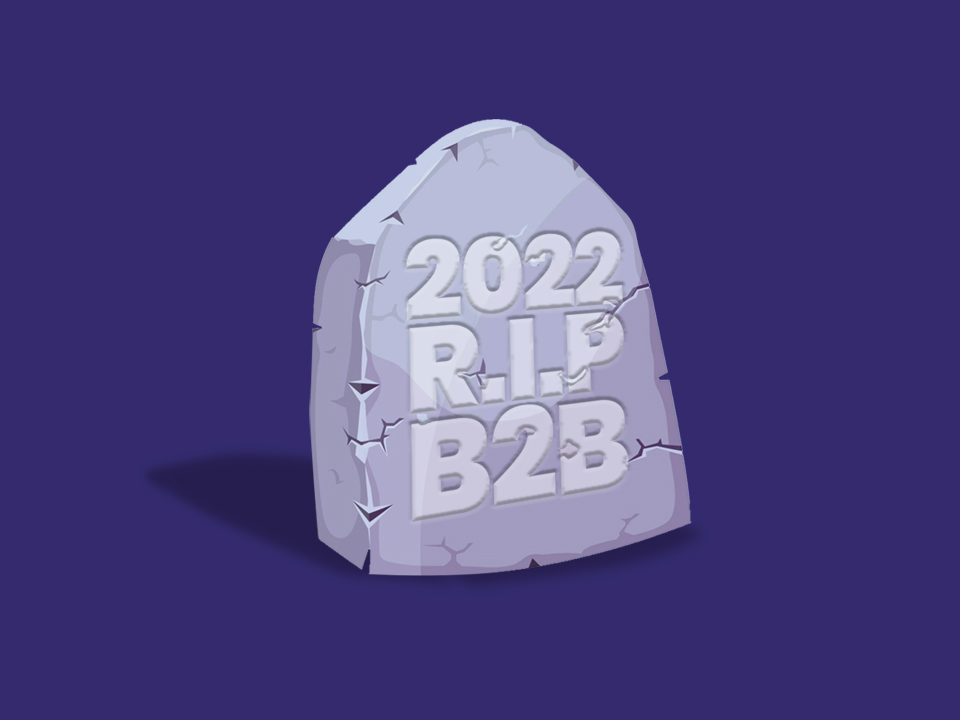
Why AI is the Foundation of ABM at Scale
February 1, 2022
Why AI is the Foundation of ABM at Scale
February 1, 20222022: The Death of B2B Marketing?

THE PAST 18 MONTHS HAVE FUNDAMENTALLY CHANGED B2B MARKETING. THE ERA OF TRADITIONAL NETWORKING AND FACE-TO-FACE MEETINGS IS GONE – AND IT’S NOT COMING BACK.
WITH THE THREAT OF NEW VARIANTS AND MORE LOCKDOWNS NOT GOING AWAY, IT’S TIME TO ACCEPT THIS ISN’T A BLIP. THE NEW NORMAL IS BECOMING JUST THAT: NORMAL.
So, What's Changed..?
Pretty. Much. Everything.
Decision makers had to adapt to the pandemic, and here’s the thing – they liked it. Research by McKinsey found that only 20% of B2B buyers want to return to in-person sales, and why would they? Remote interactions makes scheduling easier, means less travel expenses, and of course is far less likely to result in a bout of Covid.
The long and short of it is that B2B buyers have moved on from the old normal, and that creates a hell of a lot of problems for marketers.
In-person tradeshows and events are no longer in the picture. Generating leads and getting contacts through live networking is harder. And without events to go to, starting conversations with prospects is more challenging than ever.
And even if you can get a Zoom call with a prospective client, it’s just not the same. Physical meetings had all sorts of benefits that we took for granted. You could get a read on your prospect, you could build a relationship through pre and post-meeting small talk, and you knew you had their attention.
You don’t get that personal touch from remote contact. ‘Zoom fatigue’ is real. Attention spans are shorter, distractions are unavoidable, and it’s only natural people are going to be less engaged. Which, needless to say, isn’t great if you’re trying to explain to that person why they should buy your service.
How have B2B marketers reacted?
“I know you’re busy, but…”. If just reading those five little words was enough to make your heart involuntarily sink, you’re one of the many who’s inbox has likely been flooded by emails and LinkedIn messages with similarly generic pitches.
Cold outreach output has increased by 79% since the start of 2020 as marketers have sought to circumnavigate the new, digital terrain. There’s an obvious problem though: when inboxes are being flooded by similarly spammy messages, how do any of them cut through?
So, what’s the way forward?
Rule number one: stop treating B2B marketing as a set of purely tactical methods. Marketing, whether it’s to consumers or businesses, is always about building a connection. Your prospective client isn’t a chatbot. They’re living, breathing human beings and they need to be treated as such.
How do you do that? Just look at how B2C has thrived in the uncertainty. They don’t treat their customers as mere numbers on a spreadsheet. They create enhanced customer journeys online.
They do it after studying their customers and figuring out their desires and challenges. Then they use AI to gather insights and create personalised and compelling content to attract, convert, and retain customers. It’s hard work but it pays off.
Understandably, this will be challenging for B2B because the consultative elements of their work require direct Q&As and conversations that have traditionally happened face-to-face. So, what can B2B do to replicate B2C engagement strategies?
The New Toolkit
COPY B2C AND CREATE GREAT DIGITAL CUSTOMER JOURNEYS: And by that we mean copy everything that works for B2C brands. From market research to content strategy, start borrowing from the B2C playbook. B2C customer experience isn’t something exclusive to B2C. The thing about great customer experiences is that by telling their colleagues and friends, your customers will do your marketing for you.
FOCUS ON AUTHENTICITY: Don’t be a faceless business. Reorient your brand identity to bring out its values. Be human and compassionate. Most people and businesses have had a rough couple of years. Be empathetic and think from their point of view to build better connections.
INVEST IN BETTER CONTENT AND STRATEGY: More than half of all B2B buyers view at least eight pieces of content during purchase process, so it’s well worth investing in. With great content, you won’t have to chase leads. They will come to you. (Think about your prospective clients reaching out to you on LinkedIn!) How does that happen? By building thought leadership in your domain. Don’t try to sell a product or service. Sell an idea instead. Be the one others would love to quote.
CREATE MORE HUMANISED FUNNELS: Your content and its delivery have to be warm and human. You should understand the buying process and then create situation-specific outreach capable of grabbing attention and creating engagement. Understand who you’re talking to and create enriched user journeys.
DEVELOP A MULTI-FORMAT STRATEGY: Relying on a single channel to reach and engage with your audience can be fruitless. Maybe your prospect doesn’t like to read long-form articles with multiple infographics. So, how about a podcast instead? Or video highlights of a webinar that you hosted on the topic?
In a nutshell, it’s time for B2B to think big about how to engage – actually, properly engage – people online. True, the bigger scale of the internet does make prospecting more of a numbers game than it used to be. But that doesn’t mean the way forward is generic bulk messaging.
But, if you’re not sure where to begin, MyConversation can help you implement the tools and strategies to bring your processes in line with the new normal. At MyConversation, we use a targeted, AI driven approach to generate personalised and engaging outreach, and we’re always looking for fresh innovations to optimise our processes.

